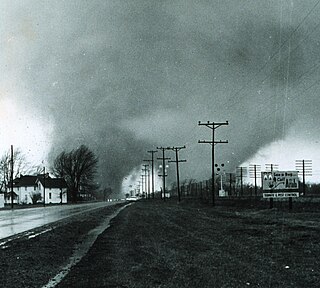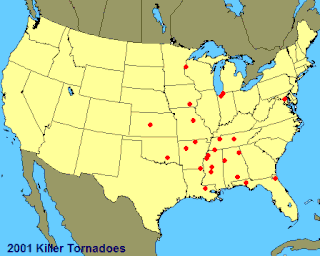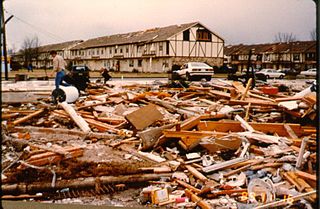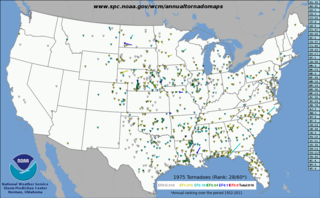
The 1974 Super Outbreak was the second-largest tornado outbreak on record for a single 24-hour period, just behind the 2011 Super Outbreak. It was also the most violent tornado outbreak ever recorded, with 30 F4/F5 tornadoes confirmed. From April 3–4, 1974, there were 148 tornadoes confirmed in 13 U.S. states and the Canadian province of Ontario. In the United States, tornadoes struck Illinois, Indiana, Michigan, Ohio, Kentucky, Tennessee, Alabama, Mississippi, Georgia, North Carolina, Virginia, West Virginia, and New York. The outbreak caused roughly $843 million USD in damage, with more than $600 million occurring in the United States. The outbreak extensively damaged approximately 900 sq mi (2,331 km2) along a total combined path length of 2,600 mi (4,184 km). At one point, as many as 15 separate tornadoes were occurring simultaneously.

On April 10–12, 1965, a devastating severe weather event affected the Midwestern and Southeastern United States. The tornado outbreak produced 55 confirmed tornadoes in one day and 16 hours. The worst part of the outbreak occurred during the afternoon hours of April 11 into the overnight hours going into April 12. The second-largest tornado outbreak on record at the time, this deadly series of tornadoes, which became known as the 1965 Palm Sunday tornado outbreak, inflicted a swath of destruction from Cedar County, Iowa, to Cuyahoga County, Ohio, and a swath 450 miles long (724 km) from Kent County, Michigan, to Montgomery County, Indiana. The main part of the outbreak lasted 16 hours and 35 minutes and is among the most intense outbreaks, in terms of tornado strength, ever recorded, including at least four "double/twin funnel" tornadoes. In all, the outbreak killed 266 people, injured 3,662 others, and caused $1.217 billion in damage.


The 1994 Palm Sunday tornado outbreak was the third notable US tornado outbreak to occur on Palm Sunday and the second to take place in the Southeastern United States. The outbreak produced 29 tornadoes from Texas to North Carolina, killing 40 people and injuring 491, and causing $140 million in damage. The deadliest storm of the outbreak, as well as in the US in 1994, was an F4 tornado that devastated Piedmont, Alabama. It struck the Goshen United Methodist Church right in the middle of the Palm Sunday service, collapsing the roof on the congregation and killing 20 people inside, including the Rev. Kelly Clem's 4-year-old daughter Hannah. Two other houses of worship were also destroyed mid-service. The supercell that formed this tornado tracked for 200 miles (322 km) to South Carolina.

The tornado outbreak of April 6–9, 1998 was a large tornado outbreak that started on April 6 across the Great Plains and ended on April 9 across the Carolinas and Georgia. A total of 62 tornadoes touched down from the Middle Atlantic States to the Midwestern United States and Texas. The outbreak is infamous for producing a deadly F5 that tore through the suburbs of Birmingham, Alabama, killing 32 people. The Birmingham tornado was one of only two F5 tornadoes that year. The other hit in Lawrence County, Tennessee, on April 16, as part of the same outbreak as the Nashville F3 tornado. This tornado outbreak was responsible for 41 deaths: 7 in Georgia and 34 in Alabama.

The 1967 Oak Lawn tornado outbreak was a destructive tornado outbreak and severe weather event that occurred on April 21, 1967, across the central Midwest, in particular the towns of Belvidere and Oak Lawn, Illinois, United States. Locally known as 'Black Friday,' it was the largest tornado outbreak of 1967 and one of the most notable to ever occur in the Chicago metropolitan area. The outbreak produced numerous and significant (F2+) tornadoes, with ten of them in Illinois alone. Included was one of just six documented violent (F4/F5) tornadoes in the Chicago metropolitan area since the area was first settled.

A destructive tornado outbreak devastated parts of the U.S. Upper Midwest on April 20, 2004. A total of 31 tornadoes formed in eastern Iowa, extending into northern and central Illinois and Indiana. A tornado that struck Utica, Illinois, was the only one to cause fatalities. The outbreak was largely unexpected, as the SPC had only predicted a "slight risk" of severe weather in the afternoon of the event.

The tornado outbreak sequence of May 2004 was a series of tornado outbreaks that affected much of southern Ontario, the Central and Southern United States from east of the Rockies to the Mid-Atlantic States from May 21 to May 31, 2004. Particularly hard hit were the central Plains from Missouri to Iowa and the Ohio Valley. The Central Plains were hit by two significant outbreaks on May 22 and May 24, the first outbreak of which produced a very large and violent tornado in Hallam, Nebraska. The Ohio Valley was affected by one of the largest tornado outbreaks ever during the Memorial Day weekend on May 29–30.

This page documents notable tornadoes and tornado outbreaks worldwide in 2006. Strong and destructive tornadoes form most frequently in the United States, Bangladesh, and Eastern India, but they can occur almost anywhere under the right conditions. Tornadoes also develop occasionally in southern Canada during the Northern Hemisphere's summer and somewhat regularly at other times of the year across Europe, Asia, Argentina, Brazil and Australia. Tornadic events are often accompanied with other forms of severe weather, including strong thunderstorms, strong winds, and hail.

This page documents notable tornadoes and tornado outbreaks worldwide in 2004. Strong and destructive tornadoes form most frequently in the United States, Bangladesh, and Eastern India, but they can occur almost anywhere under the right conditions. Tornadoes also develop occasionally in southern Canada during the Northern Hemisphere's summer and somewhat regularly at other times of the year across Europe, Asia, and Australia. Tornadic events are often accompanied with other forms of severe weather, including strong thunderstorms, strong winds, and hail.

This page documents notable tornadoes and tornado outbreaks worldwide in 2001. Strong and destructive tornadoes form most frequently in the United States, Bangladesh, and Eastern India, but they can occur almost anywhere under the right conditions. Tornadoes also develop occasionally in southern Canada during the Northern Hemisphere's summer and somewhat regularly at other times of the year across Europe, Asia, and Australia. Tornadic events are often accompanied with other forms of severe weather, including strong thunderstorms, strong winds, and hail.
A tornado emergency is an enhanced version of a tornado warning, which is used by the National Weather Service (NWS) in the United States during imminent, significant tornado occurrences in highly populated areas. Although it is not a new warning type from the NWS, issued instead within a severe weather statement or in the initial tornado warning, a tornado emergency generally means that significant, widespread damage is expected to occur and a high likelihood of numerous fatalities is expected with a large, strong to violent tornado.

The Marion, Illinois tornado outbreak was a small, severe tornado outbreak that affected southern portions of the Midwestern United States on May 29, 1982.

From May 3 to May 11, 2003, a prolonged and destructive series of tornado outbreaks affected much of the Great Plains and Eastern United States. Most of the severe activity was concentrated between May 4 and May 10, which saw more tornadoes than any other week-long span in recorded history; 335 tornadoes occurred during this period, concentrated in the Ozarks and central Mississippi River Valley. Additional tornadoes were produced by the same storm systems from May 3 to May 11, producing 363 tornadoes overall, of which 62 were significant. Six of the tornadoes were rated F4, and of these four occurred on May 4, the most prolific day of the tornado outbreak sequence; these were the outbreak's strongest tornadoes. Damage caused by the severe weather and associated flooding amounted to US$4.1 billion, making it the costliest U.S. tornado outbreak of the 2000s. A total of 50 deaths and 713 injuries were caused by the severe weather, with a majority caused by tornadoes; the deadliest tornado was an F4 that struck Madison and Henderson counties in Tennessee, killing 11.

This page documents the tornadoes and tornado outbreaks of 1989, primarily in the United States. Most tornadoes form in the U.S., although some events may take place internationally. Tornado statistics for older years like this often appear significantly lower than modern years due to fewer reports or confirmed tornadoes.

On the evening of Monday, May 3, 1999, a large and exceptionally powerful F5 tornado registered the highest wind speeds ever measured globally; winds were recorded at 301 ± 20 miles per hour (484 ± 32 km/h) by a Doppler on Wheels (DOW) radar. Considered the strongest tornado ever recorded to have affected the metropolitan area, the tornado devastated southern portions of Oklahoma City, Oklahoma, along with surrounding suburbs and towns to the south and southwest. The tornado covered 38 miles (61 km) during its 85-minute existence, destroying thousands of homes, killing 36 people, and leaving US$1 billion in damage, ranking it as the fifth-costliest on record not accounting for inflation. Its severity prompted the first-ever use of the tornado emergency statement by the National Weather Service.

This page documents the tornadoes and tornado outbreaks of 1975, primarily in the United States. Most tornadoes form in the U.S., although some events may take place internationally. Tornado statistics for older years like this often appear significantly lower than modern years due to fewer reports or confirmed tornadoes.

This page documents notable tornadoes and tornado outbreaks worldwide in 2020. Strong and destructive tornadoes form most frequently in the United States, Argentina, Brazil, Bangladesh, and eastern India, but can occur almost anywhere under the right conditions. Tornadoes also develop occasionally in southern Canada during the Northern Hemisphere's summer and somewhat regularly at other times of the year across Europe, Asia, Argentina, Australia and New Zealand. Tornadic events are often accompanied by other forms of severe weather, including strong thunderstorms, strong winds, and hail.
This page documents the tornadoes and tornado outbreaks of 1950, primarily in the United States. Most tornadoes form in the U.S., although some events may take place internationally.
Between April 23–30, 1961, a tornado outbreak sequence struck the Midwest, Ohio, and Mississippi Valleys, and the Eastern United States. Large hailstorms accompanied the tornadoes as well and numerous other weather events also occurred. Three people were killed, 38 others were injured and losses totaled $26.810 million. Two additional fatalities also occurred due to flooding and lightning.


















